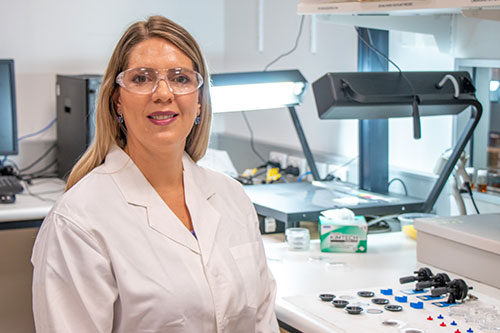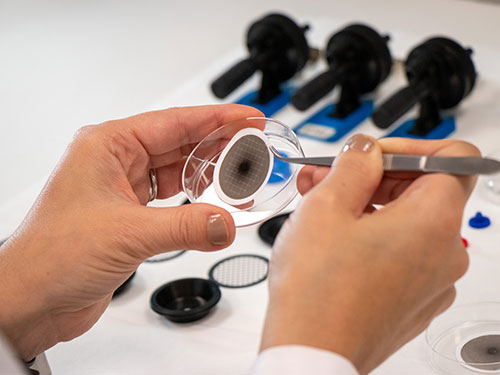The University of Queensland’s Sustainable Minerals Institute (SMI) has received close to $2.4 million from the Queensland Government Office of Industrial Relations for research into occupational dust lung diseases.
This funding will back two projects, led by Research Fellow Nikky LaBranche from SMI’s Minerals Industry Safety and Health Centre (MISHC), to improve the health and safety and treatment options for mine workers with occupational dust lung diseases.

“Improving our understanding of the risk factors of mine dust lung disease could foster advances in exposure monitoring techniques, inform the development of appropriate regulatory processes, guide return to work strategies, and produce better clinical characterisation for future clinical studies examining proposed treatments for workers,” Ms LaBranche said.
The cause of occupational lung diseases or Mine Dust Lung Disease is respirable dust released during mining, which contains mineral particles that are small enough to be inhaled deep into the lungs and can lead to long-term health problems.
Mine Dust Lung Disease includes Pneumoconiosis, Coal Workers Pneumoconiosis, silicosis, asbestosis, COPD (Chronic Obstructive Pulmonary Disease) including chronic bronchitis, emphysema and dust related diffuse fibrosis.
One of the projects will receive $1.5 million in collaboration with the University of Illinois Chicago (UIC) School of Public Health, to identify occupational and individual risk factors associated with developing respiratory diseases and the rapid progression of disease among dust-exposed workers. This project will focus on coal mines, mineral mines and quarries, and engineered stone industries in Australia.
“We don’t have a wholistic picture of the overall risk of these diseases or risk factors for development and progression,” Ms LaBranche said.
“In this project we have the potential to look at the correlation between the characterisation and the exposure and the disease prevalence.”
The UIC project will analyse existing sources of data independently and link them together with the risk factors.
“We look at the exposure data, the health data, and the lung disease diagnosis data, which would cover data sources such as industry, job tenure, job task, chest imaging, lung function testing, and dust compliance sampling,” Ms LaBranche said.
“Comparing the existing data sources to existing and collected characterisation samples from current mines we’ll be able to gather the size, shape and mineralogical components which can cause variability in toxicity of the dust.”
“My PhD work in the characterisation of the respirable dust from underground coal mines in Australia, will also be used as part of the characterisation data for this study.

The second project, which is a collaboration with the University of New South Wales (UNSW), will receive more than $827,000 to research and identify factors critical to the development, severity, and progression of coal workers pneumoconiosis (CWP or black lung) and silicosis.
The project will also focus on future treatment options for people suffering occupational lung diseases.
“This study will be combining my characterisation work with the UNSW team’s lung tissue research. This will provide the correlation between the lung tissue reactivity to the dust and the characterisation of the multiple dust sources including diesel particulate that are present in the different work environments,” Ms LaBranche said.
“We can look at how a dust sample collected from the ambient air in a mine differs from a sample of crushed ore from that mine.
“Testing a sample in isolation is great but you never know what effect that multiple mineralogies and sources would have on the lung tissue. They could cancel each other out, they could have an additive factor, multiplicative, we don’t know the extent of the interactions.”
MISHC Director Professor Maureen Hassall says these projects are a step towards improving health and safety in the industry.
“I congratulate Ms LaBranche, the Office of Industrial Relations and research partners for pursuing such important research. It will build upon the history of research projects led by Professor David Cliff of MISHC to deliver knowledge crucial for improving the health and safety of workers."
Monitoring of dust exposure has been undertaken for over 70 years but there is still little known about the composition and shape of dust particulates and the role these factors play in developing respirable dust diseases.
Ms LaBranche is leading Australia’s research in the analysis of respirable dust exposure and dust characterisation of particulates in Australian mines and analysis. Her characterisation methodology utilises a Minerals Liberation Analyser (MLA), a type of scanning electron microscope developed by JKTech, to determine the size, shape and mineralogy of individual particles down to less than a micron in size.
“Characterisation is a very important step. We need to understand what dust is being generated and what people are being exposed to because the makeup of this dust is not necessarily what you would think it would be,” Ms LaBranche said.
The projects with UIC and UNSW will both run for three years.
Media: Nikky LaBlanche, +61 (0) 407610108, n.labranche@uq.edu.au ; Sasha Ackfun, Sustainable Minerals Institute Communications Officer, +61 (0) 439 016 178, s.ackfun@uq.edu.au



